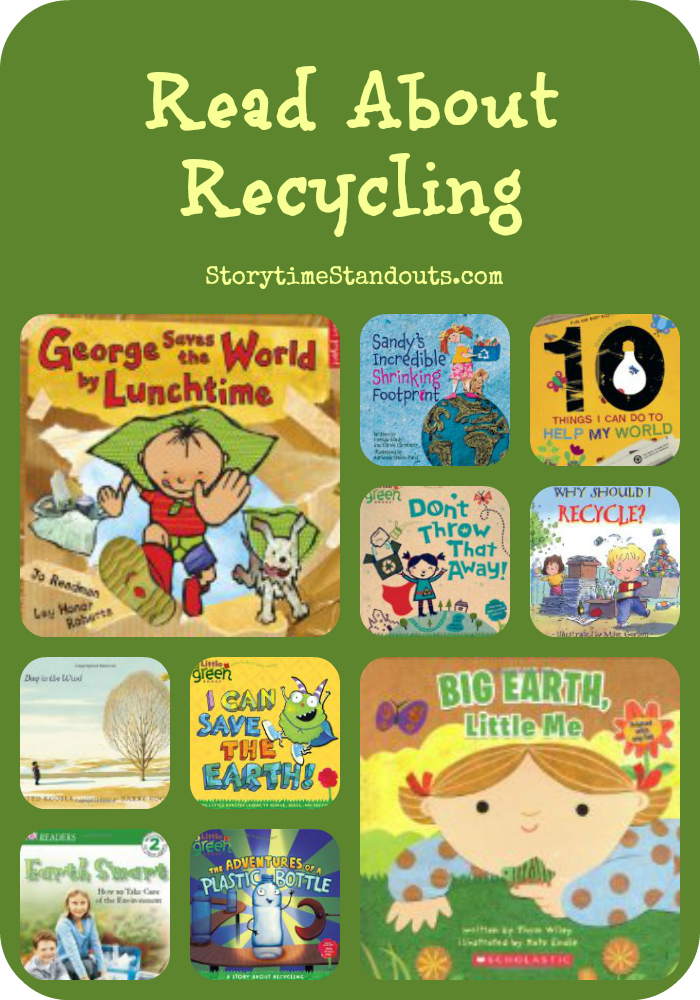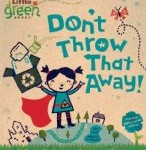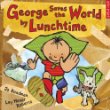Recycling
11 Terrific Picture Books About Recycling to Share with Children
Today we highlight eleven picture books about recycling. These are great resources for Earth Day and teaching ways to care for our environment. Share them at home or in your classroom and help children learn how and why to recycle household items.

Elsewhere on this site ~
-Earth Day and Environmental Awareness Picture Books
-Earth Day Printables

10 Things I Can Do to Help My World written and illustrated by Melanie Walsh
Picture book about recycling, water conservation and energy efficiency
Published by Candlewick Press
Striking die-cuts and a fun format enhance to this delightful read-aloud. Big, bold illustrations – perfect for a group setting – show readers ten ways young children can help our world and be eco friendly. With reminders to turn off the light when leaving a room, turn off the tap off when brushing teeth, put out a birdfeeder in the winter, draw on both sides of the paper and walk to school rather than drive, youngsters will feel empowered to make a difference.
Additional notes such as Every time you do this, you save eighteen glasses of water. and Turning off lights and using more efficient lightbulbs saves valuable energy. will engage and inspire older readers.
Made from 100% recycled material 10 Things I Can Do to Help My World’s eco-friendly tips are great for preschool and kindergarten. For older children, 10 Things I Can Do demonstrates creative ways to deliver important messages using eye-catching illustrations, factual information and word art.
Possible extension activities could include identifying and illustrating five or ten more ways to “help” (at school or on the playground) using like techniques.
10 Things I Can Do to Help My World at Amazon.com
10 Things I Can Do to Help My World at Amazon.ca
The Adventures of a Plastic Bottle – A Story About Recycling written by Alison Inches and illustrated by Pete Whitehead
Picture book (for older readers) about manufacturing and recycling published by Little Simon, a Division of Simon & Schuster
Written and illustrated “scrapbook-style.” The Adventures of a Plastic Bottle introduces a a thick, oozing blob of CRUDE OIL deep beneath the ocean floor. Our hero knows that one day destiny will call. Crude oil could eventually be refined into fuel, asphalt, wax or plastic. In this case, the oil is pumped from the ocean floor into a tanker and soon arrives at an Oil Refinery where it undergoes polymerization. It is transformed into plastic crumbs and sent to a manufacturing plant. At the plant, it is heated and molded into a shiny plastic bottle that oozes personality. Best suited to Early Primary students, The Adventures of a Plastic Bottle is an engaging story, enhanced by fun illustrations, interesting factoids and a glossary. It is part of Simon and Schuster’s series of “Little Green Books” and is printed on 100% postconsumer waste recycled paper.
The Adventures of a Plastic Bottle: A Story About Recycling at Amazon.com
The Adventures of a Plastic Bottle: A Story About Recycling from Amazon.ca
Bag in the Wind written by Ted Kooser and illustrated by Barry Root
Picture book (for older readers) about recycling, reusing resources, social responsibility published by Candlewick Press
Best suited to children in elementary school, Bag in the Wind is a thought-provoking story about an empty plastic bag. Although still usable, it has been discarded. It is subsequently unearthed at a landfill and is blown back into a world of plants, animals and people.
Beautifully written and illustrated, Bag in the Wind is a picture book that will challenge older readers to think about ways to reuse resources and be eco friendly.
Bag in the Wind at Amazon.com
Big Earth, Little Me
Picture book about recycling, reusing, planting a garden published by Scholastic
Featuring bright, bold collage illustrations, a ‘lift the flaps’ format and simple text, Big Earth, Little Me provides a great introduction to the idea of helping the earth and making eco friendly choices. Whether reminding youngsters to recycle, turn off the water when brushing their teeth, use a lunch box and draw on both sides of the paper or encouraging children to help in the garden, the message is simple, positive and clear.
Big Earth, Little Me at Amazon.com
Big Earth, Little Me at Amazon.ca
Don’t Throw That Away written by Lara Bergen and illustrated by Betsy Snyder
Picture book about recycling and reusing published by Simon and Schuster Canada
Don’t Throw That Away! has an upbeat, positive message for very young children: what looks like garbage may be recyclable. Discarded paper, plastic, metal and glass all belong in a recycling bin, an empty jam jar can be transformed into a vase and a plastic milk jug can become a bird feeder. Additional flaps reveal homemade musical instruments, costumes and a car made from a cardboard box.
Great for preschool-age children, the relatively small format (typical of many board books) makes it best-suited to an individual or small group setting. Would be an excellent introduction to an art or craft project reusing discarded materials.
Don’t throw That Away! screensaver
Simon and Schuster’s Circle the Items That Are Recyclable activity
Don’t Throw That Away! at Amazon.com (Little Green Books)
Don’t Throw That Away! at Amazon.ca (Little Green Books)
Earth Smart How to Take Care of the Environment – written by Leslie Garrett
Early Reader about recycling, waste reduction, conserving energy, pollution published by Dorling Kindersley
Part of Dorling Kindersley’s DK Readers series, Earth Smart is appropriate for children aged 7 to 9. Generously illustrated with photographs, it is rated “Level 2, Beginning to Read Alone.” Introducing ways we can help to look after the environment, content touches on recycling, a look at a landfill, disposing of toxic substances, reducing energy consumption, dangers of pollution and global warming, the benefits of enjoying eco friendly local produce and ways trees help us.
Leslie Garrett’s Blog The Virtuous Consumer
George Saves the World by Lunchtime
Written by Jo Readman and illustrated by Ley Honor Roberts
Picture book about recycling, reusing and reducing waste published by Random House
Wearing a makeshift superhero cape, George announces his plans for the day, “I’m going to save the world!” Grandpa and his sister are willing to help and it is not long before the trio is finding ways to reduce, reuse, repair and recycle. Large, colourful collage ilustrations include photos and drawings. Readers learn about reducing electrical consumption by hanging laundry to dry, minimizing fuel consumption by walking or riding a bicycle and the importance of turning lights off. Suggestions are also made for recycling, donating, repairing and buying locally produced eco friendly items.
This book was inspired by The Eden Project an educational charity in Cornwall, England. It is worth noting that a sidebar refers to most electrical energy being produced by burning coal. This may or may not be true, depending on where the book is read. In addition, a suggestion is made that animal waste can be added to compost. This suggestion should have included the proviso that the compost ought not to be used for fruit or vegetable crops.
Cheerfully making suggestions without sounding preachy or extreme, George Saves the World by Lunchtime will be a positive addition to an eco-friendly (preschool or kindergarten) classroom or a home library.
George Saves the World by Lunchtime at Amazon.com
George Saves the World By Lunchtime at Amazon.ca

Hey, That’s Not Trash But Which Bin Does It Go In? by Renee Jablow and illustrated by Mike Byrne
Interactive Board Book about recycling published by Simon and Schuster
A hands-on opportunity for young children to sort press-out pieces into recycling bins while enjoying a story about a soccer-playing boy. Hey, That’s Not Trash lends itself to discussion about how to build smart habits when dealing with household or school waste such as cardboard, newspaper, plastic jugs and empty cans. The book would easily lead to extension activities at home or in a group setting, such as having children redirect and sort household items to a recycling bins.
Hey, That’s Not Trash does not explain what recycling entails or how it is done. Instead, the story focusses on how children and families can make a difference by redirecting unwanted items away from landfills and into recycling programs.
The boardbook format that I read is best-suited to one-on-one reading or small groups of very young children.
Hey, That’s Not Trash!: But Which Bin Does It Go In? at Amazon.com
Hey, That’s Not Trash!: But Which Bin Does It Go In? at Amazon.ca
I Can Save the Earth! – written by Alison Inches and illustrated by Viviana Garofoli
Picture book about the environment published by Simon and Schuster
Max is a Little Monster in more ways than one. He not only looks like a monster, he behaves like one. He litters wherever he goes, he uses too much water and toilet paper in the bathroom and he forgets to turn the lights and tv off when he leaves the room. As well, he is greedy with his toys: even when he’s outgrown them, he keeps them all to himself. One evening, he is watching his favourite television show when there is a power failure. When Max goes outside, he surprised by what he sees and hears. In the moonlight, Max notices flowers blooming and he hears crickets and an owl. When Max sees a shooting star, the transformation to “green” is complete. and, even when the power is restored, Max notices the natural world and takes eco friendly steps to make it better. He collects litter at the beach and learns to compost garden refuse. His wasteful bathroom habits change and he remembers to turn off lights. He decides, “fresh air feels good on my fur!” and is committed to recycling, eating healthy foods and trading toys with his friends. End notes include a glossary of terms used in the story I Can Save the Earth!: One Little Monster Learns to Reduce, Reuse, and Recycle is an introductory resource and is best suited to children aged four to six.
Note: This 8″x8″ paperback book is printed on 100% post-consumer waste (Forest Stewardship Council certified) recycled paper with soy-ink.
I Can Save the Earth at Amazon.com
I Can Save the Earth at Amazon.ca
Sandy’s Incredible Shrinking Footprint
Picture book about one’s ecological footprint published by Second Story Press
Sandy’s Incredible Shrinking Footprint tells the story of a young girl who, while visiting her grandpa, happily runs to a nearby beach. She loves to explore the seashore and is shocked to find a pile of garbage others left near a fire pit. She is disgusted by the waste and works to collect the candy wrappers, pop cans and mustard bottles. Before long, she meets an old woman who roams the beach and collects the litter others have left behind. The woman encourages the girl to consider, “The footprint of your life – the mark you leave on the world.”
This breezy, empowering picture book includes colourful collage illustrations made from natural and recycled materials. Suitable for children aged six and up.
Sandy’s Incredible Shrinking Footprint at Amazon.com
Sandy’s Incredible Shrinking Footprint at Amazon.ca
Why Should I Recycle? written by Jen Green and illustrated by Mike Gordon
Picture book about recycling
Why Should I Recycle? is part of a series of books that includes Why Should I… Save Energy, Save Water, and Protect Nature. It explains that items typically tossed into the garbage often can be reused. On a field trip to a recycling center, Mr. Jones explains that bottles, cans, plastic, clothing and paper can all be used again. Additional suggestions include composting, donating used clothing, books and toys, reusing plastic bags and choosing to buy items made from recycled materials.
Endnotes for teachers and parents include suggestions for points to discuss as well as follow-up activities and a list of books about pollution, conserving energy and recycling.
Best for children aged 4 – 6, Why Should I Recycle? provides an introduction to this subject and is well-suited for use in a classroom library.
Why Should I Recycle? at Amazon.com
Why Should I Recycle? at Amazon.ca

















































